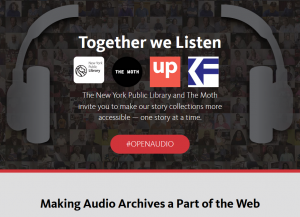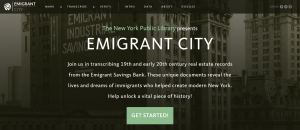This week I had the opportunity to discuss one of my favorite aspects of Digital Humanities – Crowdsourcing – during our annual DH Summer Symposium. Ever since the NYPL introduced me to the practice back in 2007 with their “What’s on the Menu?” transcribing project I have been enamored with crowdsourcing. In my presentation I pulled from Melissa Terras’ (2015) to define what is meant by crowdsourcing:
“the harnessing of online activities and behavior to aid in large-scale ventures such as tagging, commenting, rating, reviewing, text correcting, and the creation and uploading of content in a methodical, task-based fashion (Holley, 2010) – to improve the quality of, and widen access to, online collections”
I also include Citizen Science under the umbrella of crowdsourcing as that movement is built on collecting and analyzing data that is submitted by the general public. A more simplified definition of crowdsourcing is presented by Zooniverse, a website dedicated to crowdsourcing projects and a partner of the NYPL Labs on the Emigrant City project:
People-powered research
For me the magic of crowdsourcing is its ability to engage everyday citizens with humanities and science research in order to create a more active and informed public. There is no better way to explain the continued value and relevance of a degree in the Arts & Sciences than to be able to point to research projects that are able to create a community that straddles both the academic and everyday worlds. As the NYPL Labs once wrote:
With every menu transcribed and map rectified, users are supporting research in the humanities.
Even though the NYPL Labs closed in late 2016 its influence lives on through ongoing projects such as:
And through the use of the programs and tools that they developed and are currently shared on GitHub.
The Seton Hall University Library Collections offer ample opportunity to tap into the power of crowdsourcing and I look forward to seeing what projects the campus DH Committee will contribute to the community of crowdsourcing.
References:
All Hands on Deck: NYPL Turns to the Crowd to Develop Digital Collections. (n.d.). Retrieved May 22, 2017, from https://www.nypl.org/blog/2011/09/15/all-hands-deck-nypl-turns-crowd-develop-digital-collections
The New York Public Library. (n.d.). Retrieved May 25, 2017, from https://github.com/NYPL
NYPL Labs. (Archived). Retrieved May 25, 2017, from https://www.nypl.org/collections/labs
NYPL/Zooniverse. (n.d.). Emigrant City. Retrieved May 25, 2017, from http://emigrantcity.nypl.org/#/
Terras, M. (2015). Crowdsourcing in the Digital Humanities. In S. Schreibman, R. Siemens, & J. Unsworth (Eds.), A New Companion to Digital Humanities (pp. 420–438). John Wiley & Sons, Ltd.
Together We Listen. (n.d.). Retrieved May 25, 2017, from http://togetherwelisten.nypl.org/

